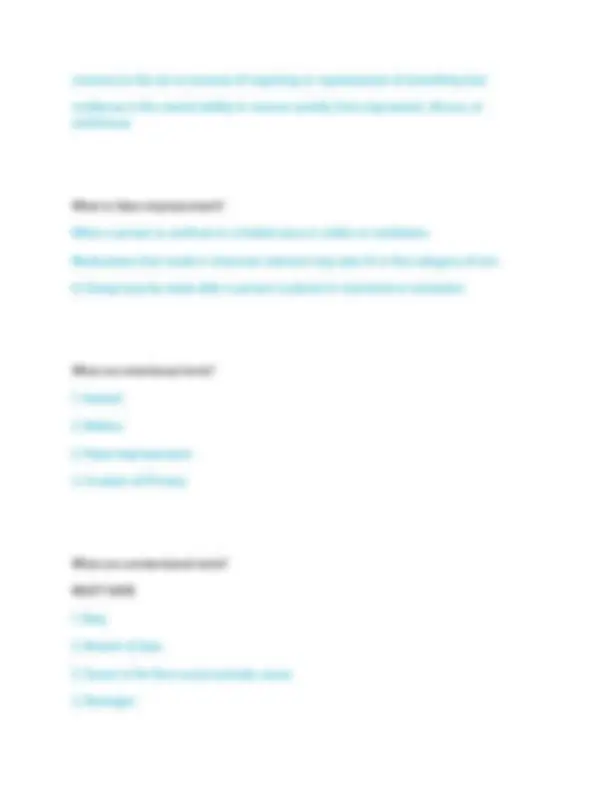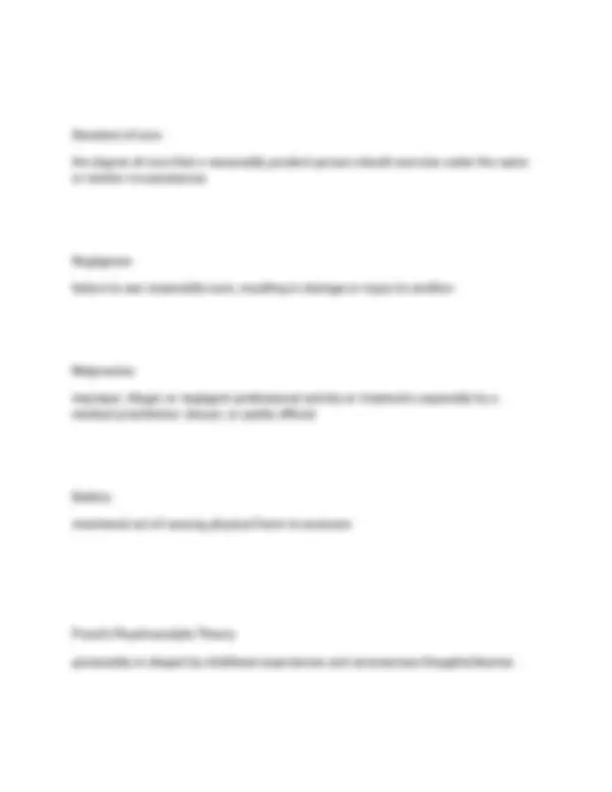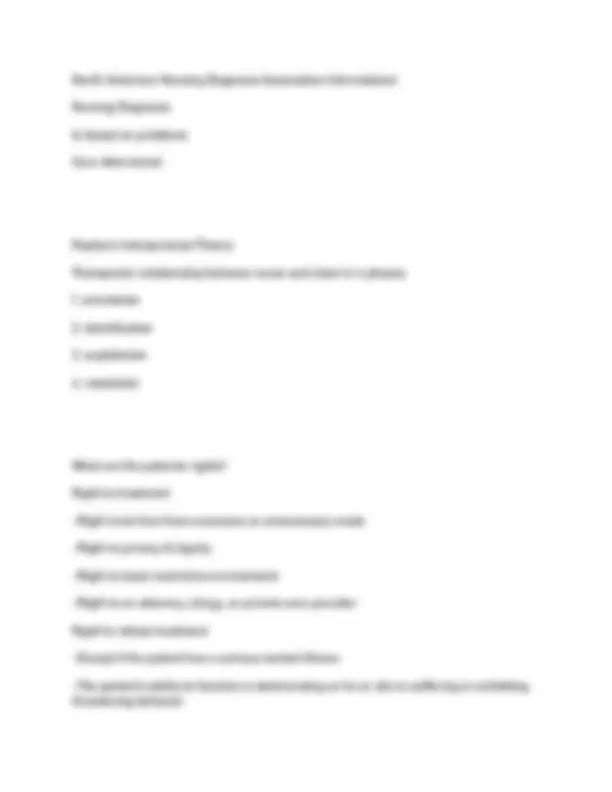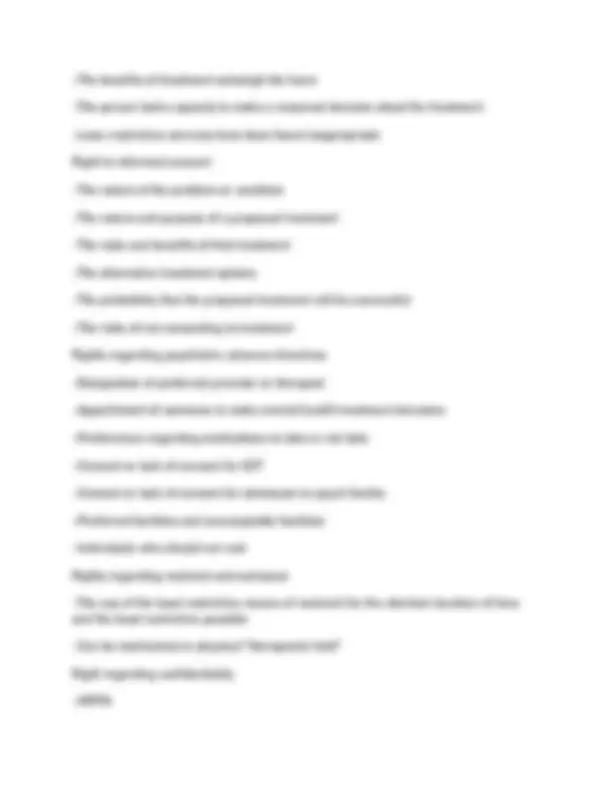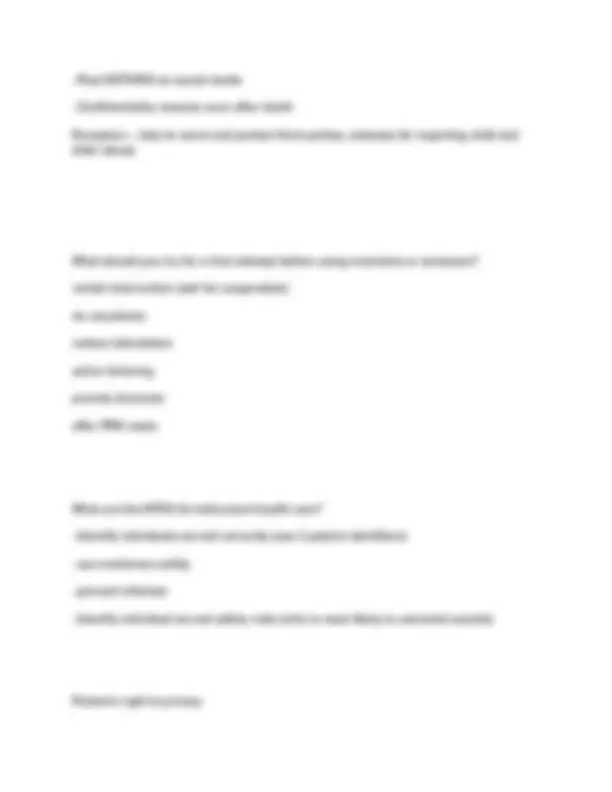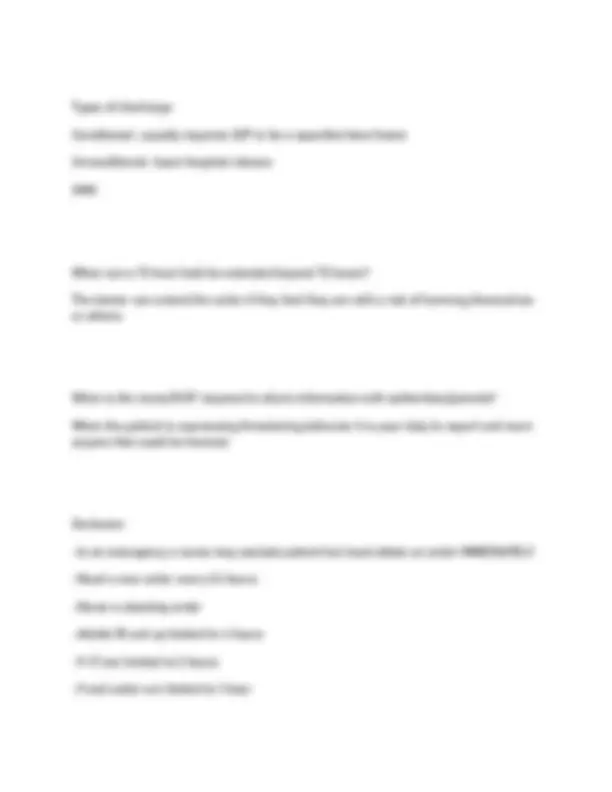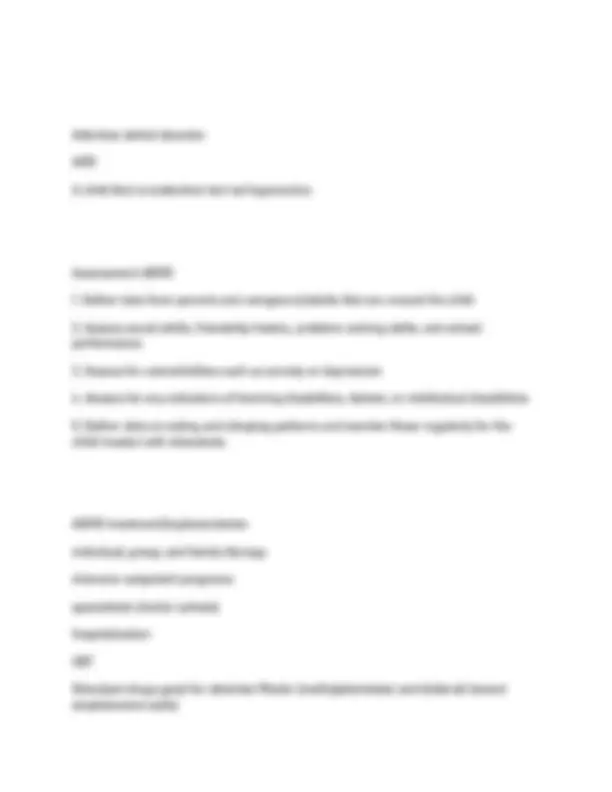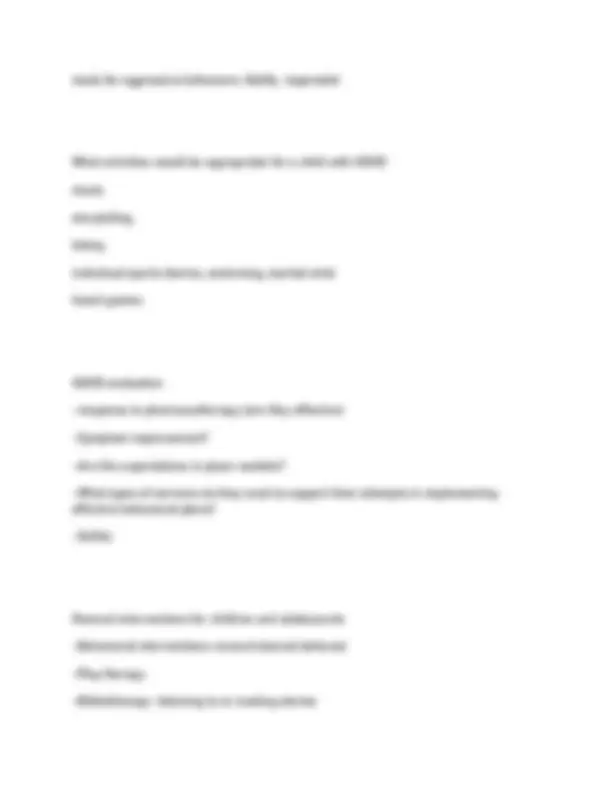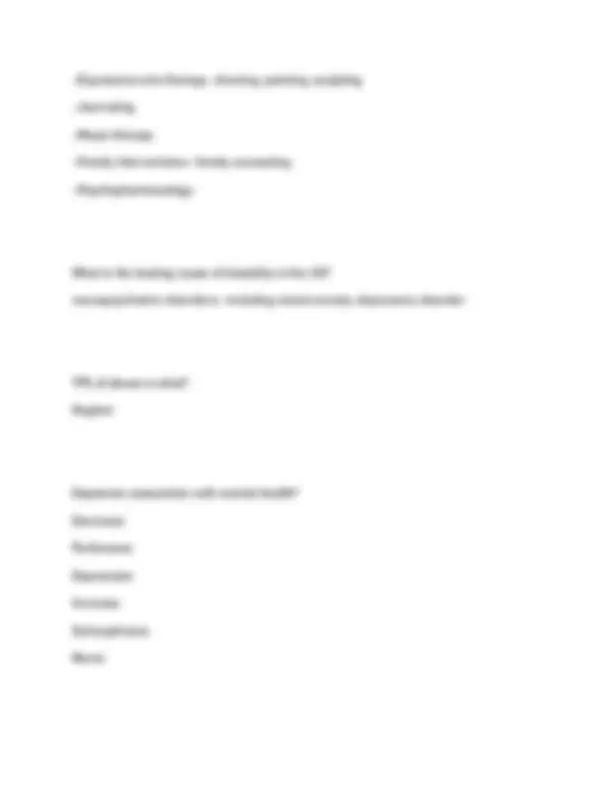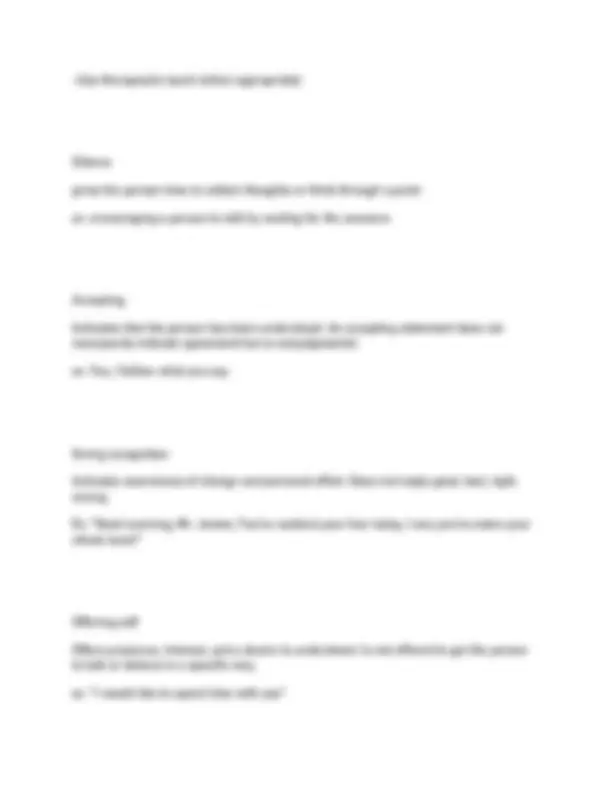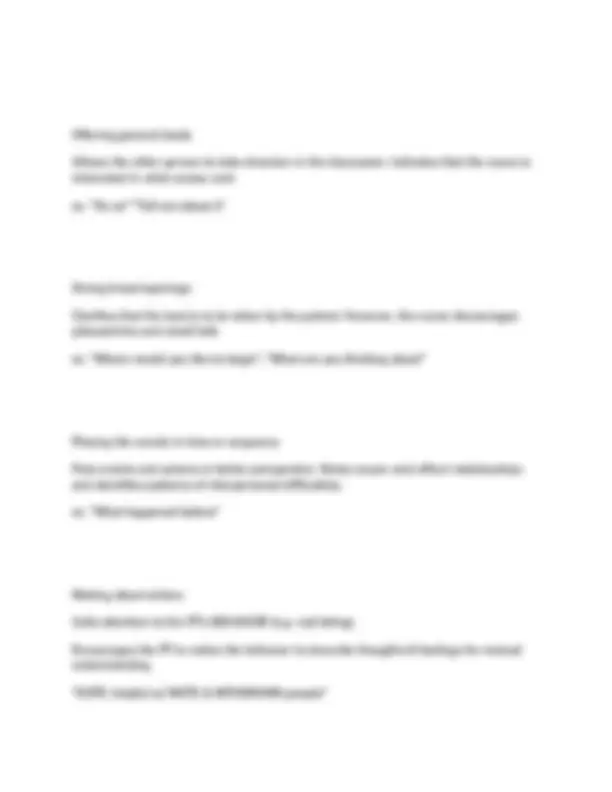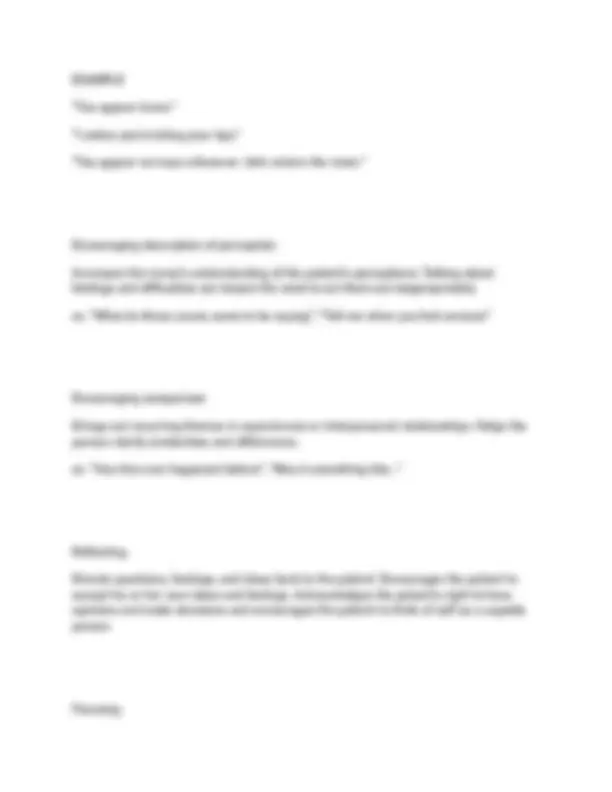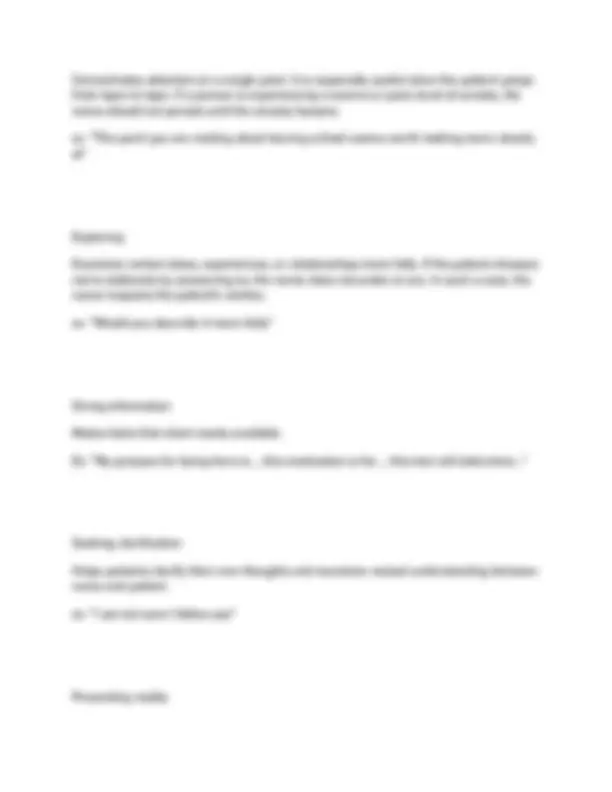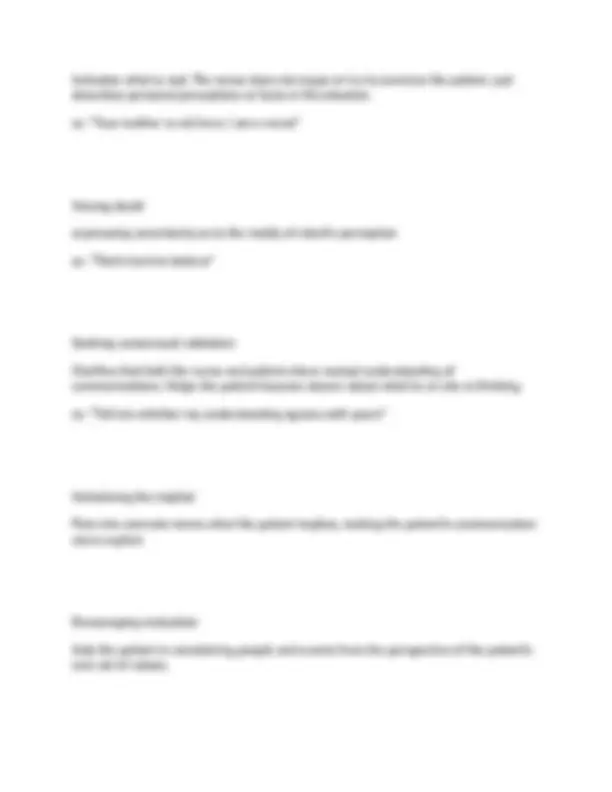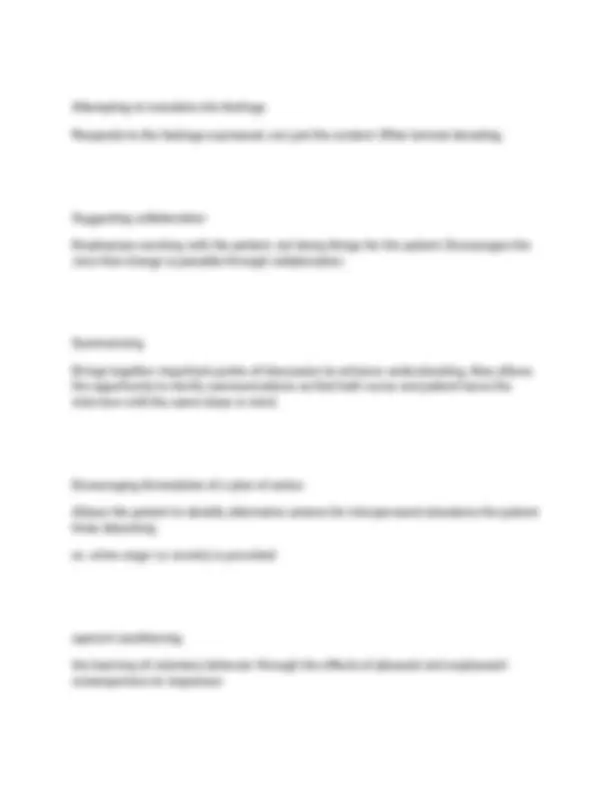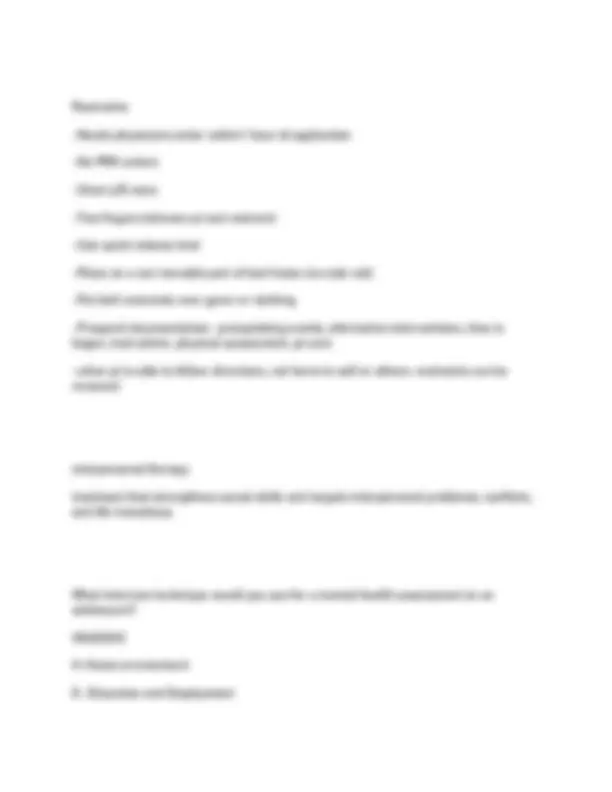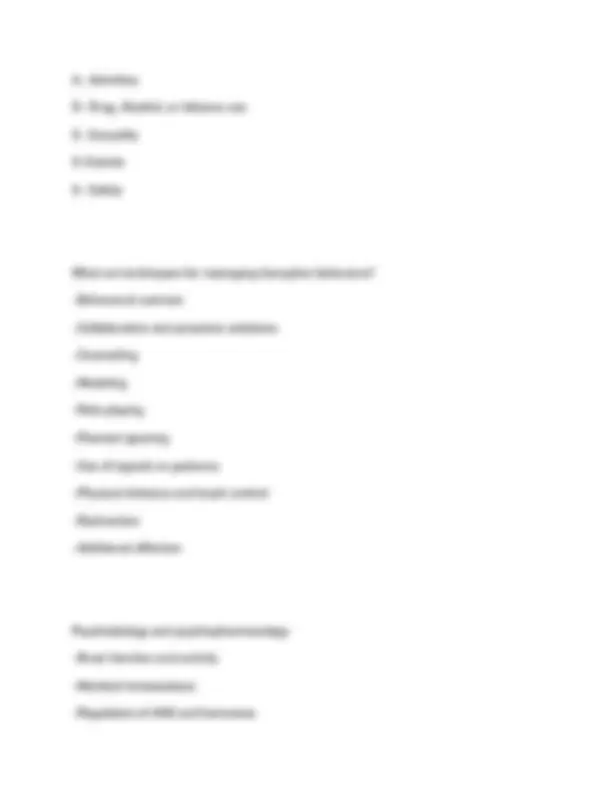Download HONDROS NUR 233 Concepts of Mental Health Nursing 2025/2026 Questions with Correct Answers and more Exams Nursing in PDF only on Docsity!
HONDROS NUR 233 Concepts of Mental Health
Nursing 2025/2026 Questions with Correct
Answers (Original Exam) Score A
Therapeutic communication The ability to form patient-centered relationships is fundamental and essential to effective nursing care
- Crucial to the formation of patient-centered therapeutic relationships Factors affecting communication Personal factors: Psychiatric disorders- depression can slow the thinking which slows communication
- anxiety can cause a lack of concentration
- Mania causes in ability to focus for any length of time Language barriers Cultural differences Cognitive factors Environmental Factors: background noise, lack of privacy, uncomfortable accommodations
Types of communication Verbal- the spoken word Nonverbal- Tone of voice
- emphasis on certain words
- pace of speech
- body posture
- eye contact
- hand gestures
- fidgeting How long does an order for seclusion last Orders are good for 24 hours under 18 2 hours at a time over 18 4 hours at a time Nurse can isolate pt if they are feeling threatened When is a nurse able to decline floating to an inpatient psych unit? If they feel uncomfortable, threatened, or like they are in harms way. Resilience compared to recovery
unintended acts against another person that produce injury or harm. At what age is autism usually diagnosed? First 3 years of life Usually appears in early childhood Autism assessment
- Assess for developmental delays, uneven development, or loss of acquired abilities.
- Assess the child's communication skills (verbal and nonverbal), sensory, social, and behavior skills
- Assess the parent-child relationship for evidence of bonding, anxiety, tension, and fit of temperaments.
- Assess for physical and emotional signs of possible abuse. Be aware that children with behavioral and developmental problems are at risk of abuse.
- Ensure that screening for comorbid intellectual disability has been completed
- Assess the need for community programs with support services for parents and children including parent education, counseling, and after-school programs. What are some examples of therapeutic communication techniques? Silence Accepting Giving recognition
Offering self Giving broad openings Placing the events in time or sequence making observations Encouraging description of perception Encouraging comparison Restating Nontherapeutic Communication Techniques Giving premature advice Minimizing feelings Falsely reassuring Making value judgments Asking "why" questions Asking excessive questions Giving approval, agreeing
Tertiary prevention Treatment, Prevent disease from progressing to disability or death What is Adderall (mixed amphetamine salts), Vyvanse (lisdexamfetamine dimesylate), and Ritalin (methylphenidate) used for? Response: Increase attention and task-directed behavior Reduce Impulsivity, restlessness, and distractibility When prescribed... takes 2-4 weeks to get a good baseline, get a good assessment, look for side effects Adderall, Vyvanse and Ritalin side effects/adverse effects S/E Insomnia (assess sleep) Appetite suppression (assess weight, give with food or after meals) Headache Abdominal Pain (give meds with bf or lunch)
Lethargy A/E Agitation Exacerbation of psychotic thought process Growth suppression (assess weight, appetite) High Abuse Potential Maslow's Hierarchy of Needs Provides a framework to prioritize nursing diagnosis Needs below must be met before you can move up to the next stage What is the criteria for involuntary admission? Most patients are admitted to I/P care involuntarily and are placed in locked units. Locked units provide privacy and reduce the risk of elopement
Standard of care the degree of care that a reasonably prudent person should exercise under the same or similar circumstances Negligence failure to use reasonable care, resulting in damage or injury to another. Malpractice improper, illegal, or negligent professional activity or treatment, especially by a medical practitioner, lawyer, or public official. Battery intentional act of causing physical harm to someone Freud's Psychoanalytic Theory personality is shaped by childhood experiences and unconscious thoughts/desires
Freuds Psychoanalytical Theory stages ID- source of all drives instincts, reflexes, and needs; can not tolerate frustration, unable to problem solve, is illogical, wants instant gratification; a screaming toddler (ID= kid, babies) Ego- problem solver and reality tester, ego attempts to navigate the outside world. A hungry person plans to make dinner (25 yo self) kids show around 1 yr age Superego- consists of all the learned "should and should nots' causes feelings of guilt and pride (drunk frat boy) 3-5 yo Sullivan's Interpersonal Theory The purpose of all behavior is to get needs met through interpersonal interactions and to decrease or avoid anxiety. Theory that dysfunctional human interaction leads to mental illness Interpersonal therapy treatment based on interpersonal theory that works to reduce or eliminate psychiatric symptoms, strengthen social skills and targets interpersonal problems, conflicts, and life transitions Transference
North American Nursing Diagnosis Association International Nursing Diagnosis Is based on problems Care determined Paplau's Interpersonal Theory Therapeutic relationship between nurse and client in 4 phases
- orientation
- identification
- exploitation
- resolution What are the patients rights? Right to treatment
- Right to be free from excessive or unnecessary meds
- Right to privacy & dignity
- Right to least restrictive environment
- Right to an attorney, clergy, or private care provider Right to refuse treatment
- Except if the patient has a serious mental illness
- The patient's ability to function is deteriorating or he or she is suffering or exhibiting threatening behavior
- The benefits of treatment outweigh the harm
- The person lacks capacity to make a reasoned decision about the treatment
- Less-restrictive services have been found inappropriate Right to informed consent
- The nature of the problem or condition
- The nature and purpose of a proposed treatment
- The risks and benefits of that treatment
- The alternative treatment options
- The probability that the proposed treatment will be successful
- The risks of not consenting to treatment Rights regarding psychiatric advance directives
- Designation of preferred provider or therapist
- Appointment of someone to make mental health treatment decisions
- Preferences regarding medications to take or not take
- Consent or lack of consent for ECT
- Consent or lack of consent for admission to psych facility
- Preferred facilities and unacceptable facilities
- Individuals who should not visit Rights regarding restraint and seclusion
- The use of the least restrictive means of restraint for the shortest duration of time and the least restrictive possible
- Can be mechanical or physical "therapeutic hold" Right regarding confidentiality
- HIPPA
The justifiable expectation on the part of a patient that the information in his or her health record will be used only in the context of providing healthcare services
- They have the right to refuse tx, medications
- They have the right to confidentiality Mandatory reporting Nurses are mandated to report any suspicion of abuse (child or elder abuse, domestic violence) following facility policy. Warn 3rd parties if they are at risk informed consent Patient gives consent for a procedure to be performed in full knowledge of the procedure and the risk it entails
- Make sure provider has educated patient
- Witness signature of document
- Make sure pt is competent
- Make sure pt has no questions, if they do have provider answer Entry to Acute Inpatient Care
- Direct admission on referral
- Emergency department or crisis service
- can be voluntary or involuntary
Voluntary admission admission to a facility sought by patient or guardian What is informal admission? One type of voluntary admission that is similar to any general hospital admission in which there is no formal or written application; the patient is free to stay or leave, even against medical advice. involuntary commitment
- A court-ordered admission to a facility without the patient's consent
- Pink slip
- The patient must be mentally ill
- The patient must pose a danger to self or others
- They must be unable to provide for their basic needs
- Their mental illness prevents help-seeking on a voluntary basis Emergency commitment when an acutely disturbed individual is temporarily confined, typically for no more than a few days.
- After 24 hours a physician must personally assess the pt. attention deficit hyperactivity disorder
- ADHD
- show an inappropriate degree of inattention, impulsiveness, and hyperactivity.
- Occurs in early childhood before age 12
- Higher in boys than girls
- Often have comorbid disorders (oppositional defiant disorder, conduct disorder, disruptive mood disorder, specific learning disorder) behaviors and symptoms of ADHD hyperactivity impulsivity poor peer relationships poor social boundaries intrusive behaviors interrupts others may be distracted easily disorganized become easily bored lose things frequently may be unable to complete challenging tasks
Attention deficit disorder ADD A child that is inattentive but not hyperactive Assessment ADHD
- Gather data from parents and caregivers/adults that are around the child
- Assess social skills, friendship history, problem-solving skills, and school performance.
- Assess for comorbidities such as anxiety or depression
- Assess for any indicators of learning disabilities, Autism, or intellectual disabilities
- Gather data on eating and sleeping patterns and monitor these regularly for the child treated with stimulants ADHD treatment/implementation individual, group, and family therapy intensive outpatient programs specialized charter schools hospitalization CBT Stimulant drugs good for attention Ritalin (methylphenidate) and Adderall (mixed amphetamine salts)

